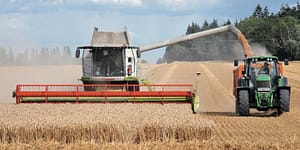A Year of Global Birdwatching: The Thrill Of the Chase

When Arjan Dwarshuis first heard of the “Big Year,” the legendary record for birdwatching, he was twenty years old and he was sitting on the roof of a truck in the Andean Mountains. In that moment he promised himself that, someday, somehow, he would become a world-record-holding birder. Ten years later, he embarked on an incredible and perilous journey that took him around the globe; over uninhabited islands, through dense unforgiving rainforests, across snowy mountain peaks and unrelenting deserts—in just a single year.
In this foreword, fellow bird watcher and Big Year participant Mark Obmascik highlights Dwarshuis’ year-long journey.
The following is an excerpt from The (Big) Year That Flew By by Arjan Dwarshuis. It has been adapted for the web.
Featured image by Arjan Dwarshuis.
The (Big) Year That Flew By: A Foreword by Mark Obmascik
If you had one year of your life to do whatever you wanted—no work or family obligations—what would you do? Some people might hang out on a beach, or golf, or visit wineries or baseball stadiums or art museums.
Then there’s Arjan Dwarshuis.
He chased birds.
Not just in his neighborhood park but around the world—across six continents, forty-one countries, fifteen seas, and five oceans. With binoculars and spotting scopes, he followed birds through jungles and deserts, on beaches and atop mountains, in landfills and dark alleys and sewage lagoons. He welcomed the dawn chorus of songbirds nesting in prairies and wished a good night to owls and nightjars hunting in dark forests. He logged 140,000 kilometers by plane, train, automobile, horse, bus, canoe, bike, ferry, motorcycle, truck roof, and hiking boots. He rode two rickshaws, too, as well as a van that kept blowing out its radiator in the remote savannah of Uganda.
He braved cyclones in Australia, blizzards in Minnesota and Patagonia, monsoon in Vietnam, and mudslides in Guatemala. It’s hard to say what gave him more of a fright—the tiger that killed two cows just outside his vehicle in India, the two burly toughs who sandwiched him in the backseat of his transport in Papua New Guinea, or the malaria in Suriname!
Or maybe the scariest thing was really that iffy chicken tikka masala from the street vendor just south of the Himalayas. That one really hurt. For a while.
Breaking Records and Beating the Clock
For one entire year, Arjan Dwarshuis was consumed by birds, and for one year, the birds nearly consumed him. He gave up his job as a bartender in Amsterdam—he had poured Heinkens in a joint across the street from the Anne Frank Museum—and was at home in his apartment for only 5 of 366 days that year. (He planned all this for a Leap Year to give himself an extra day of birding in the field.)
His beat-the-clock obsession was magnificent, grueling, and enlightening. Borderline crazy, too.
The result was something no human in history ever had done — Arjan Dwarshuis saw 6,852 avian species in one year, nearly two-thirds of all birds known to exist on earth.
It all amounted to something birders call a Big Year, a once-in-a- lifetime chance to release the brakes on your life and let yourself be engulfed in an unparalleled global adventure. Birders around the world dream of doing a Big Year. Dwarshuis did the biggest one ever—at age twenty-nine.
The logistics alone would be enough to drive most people mad. Do the math. To break the existing Big Year world record, Dwarshuis needed to see seventeen different species of birds every day. Seventeen per day, every day, all year long. That assumes zero days of rest.
Dedication & Determination: How Did He Do It?
What complicates matters is that many birds are extremely particular about where they roost. If you live in a city, you might be able to find a pigeon or starling just about anywhere. But the only place in the world to see a Horned Guan, for example, is a 100-mile stretch of undisturbed evergreen forest along the mountainous west coast of Guatemala and Mexico. The gigantic Philippine Eagle—also known as the Monkey Eagle, for its dietary preference—can be found, believe it or not, only in the Philippines. The Geomalia, a shy rufous ground hopper with no known song, has never strayed from the difficult Sulawesi montane rain forests of Indonesia.
None of these areas are easy to reach. And even if you can arrange travel to these remote avian habitats, there is no guarantee the birds will be waiting. Lynyrd Skynyrd was right—the world is populated with free birds, who come and go as they please. For every Gunnison Sage-Grouse, which typically remains within a few miles of its origi- nal nest, there is a Bar-tailed Godwit, which flies 8,000 miles nonstop over the Pacific Ocean during semiannual migratory trips from Alaska to Tasmania and back.
To see as many species in as little time as possible—remember his relentless 17 bird-per-day mandate—Dwarshuis placed high priority on visiting the geographic pinch points of Panama and Israel, where millions of birds funnel through each spring and fall. Bird migration remains one of the world’s greatest natural phenomena, an incredible spectacle that, for the unaware, remains hidden in plain sight. Dwar- shuis didn’t just get to see it. He lived it.
Of course, none of this was cheap. But it wasn’t as expensive as you might think, either. By shrewdly lining up corporate sponsorships, bird guide partnerships, international friendships—and a few well- timed loans from the Bank of Dad—Dwarshuis was able to complete his worldwide expedition for a total cost of $65,000.
As you sit in your comfortable chair at home, turning the pages of this book, think about that price. Maybe you, too, could scratch up that kind of money. Maybe you, too, could negotiate a year of global travel on the fly. Maybe you, too, could see some of the rarest and most gorgeous creatures in some of the most spectacular landscapes on earth.
Or maybe you could just enjoy reading about someone who had the heart to do it himself. You don’t have to own binoculars to be inspired by this wild adventure story. You just need imagination and dreams.
—Mark Obmascik, author of The Big Year: A Tale of Man, Nature, and Fowl Obsession
Recommended Reads
Turning My Farm into an Ark for Lost Species: Not a Lark or a Lizard Lived There
Recent Articles
Have you heard of silvopasture? This system of managing grazing animals is an ancient practice that integrates trees and pasture into a single system for raising livestock. These systems are managed for both forest products and forage, providing short-and long-term income sources in a mutually beneficial way for healthier animals, better soil, less pest control and mowing, and…
Read MoreOxeye daisies are one of the most important plants for pollinators including beetles, ants, and moths that use oxeye daisies as a source of pollen and nectar. Instead of thinking about removing a plant like oxeye daisy, consider how you can improve the fertility and diversity of habitat resources in your home landscape, garden, or…
Read MoreThis long-lived perennial legume is used for forage and erosion control. Kudzu is edible with many medicinal uses and other applications. Pollinators of all kinds love its prodigious lavender blooms!
Read MoreMove aside, maple! We have two new syrups to add to the table. Read on for insights on tapping, selling, and eating syrup from walnut & birch trees.
Read MoreWhy is modern wheat making us sick? That’s the question posed by author Eli Rogosa in Restoring Heritage Grains. Wheat is the most widely grown crop on our planet, yet industrial breeders have transformed this ancient staff of life into a commodity of yield and profit—witness the increase in gluten intolerance and ‘wheat belly’. Modern…
Read More









